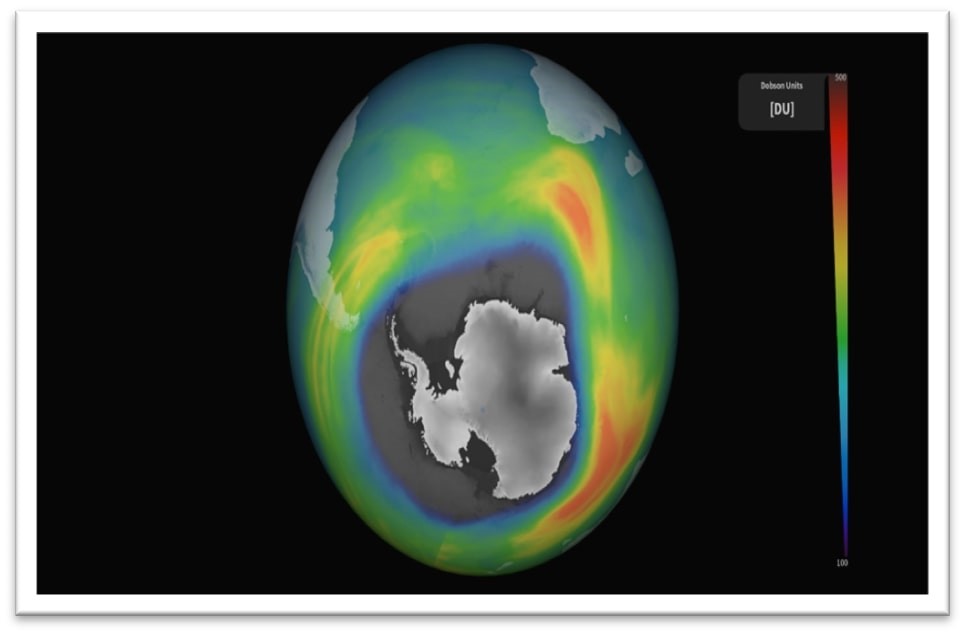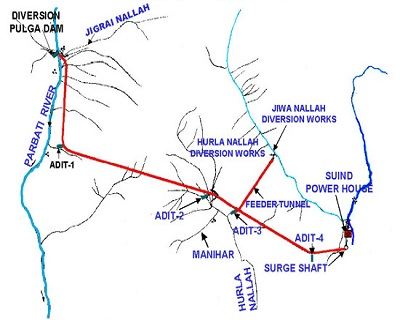Description

Disclaimer: Copyright infringement not intended.
Context
- The Antarctic ozone hole grew to 10 million square miles in size at its largest on September 21, 2023.
- This data comes from an analysis of satellite and balloon-based observations by the United States National Oceanic and Atmospheric Administration (NOAA) and National Aeronautics and Space Administration (NASA).
Details
About Ozone
- An oxygen molecule, which we breathe in every day, is typically composed of two oxygen atoms (O2 illustrating two oxygen atoms).
- However, ozone, another oxygen-containing molecule, includes three oxygen atoms (O3) instead.
- Oxygen (O2) accounts for 21% of the Earth's atmosphere, while ozone accounts for less than 0.001%.
Production
- The interaction of ultraviolet (UV) energy from the Sun with O2 molecules produces ozone molecules.
- After splitting an O2 molecule, the two liberated oxygen atoms join with additional O2 molecules to generate O3 molecules.
The ozone layers
- Because UV light is more powerful at higher altitudes where the air is thinner, most ozone is created in the stratosphere, giving rise to the ozone layer.
- The ozone layer has an altitude range of roughly 10 to 40 kilometers, with a maximum of about 25 kilometres.
Significance
- The ozone layer is critical for life on Earth because it absorbs the most harmful kind of UV radiation, UV-B radiation.
- The wavelength of this is between 280 and 315 nanometres.
- Because most skin cancers are caused by excessive UV radiation, anything that protects us from UV rays helps reduce cancer rates.
- When UV radiation is absorbed by ozone in the stratosphere, it heats the surrounding air, resulting in a stratospheric temperature inversion.

Measuring stratospheric ozone
- In Dobson units, ozone is defined as the total amount contained in a column of an overlying atmosphere.
- One Dobson unit represents the amount of ozone present if it formed a 0.01mm thick layer at typical sea-level pressure and temperature.
Where does Ozone come from?
- The majority of stratospheric ozone is created at tropical latitudes, but high-altitude winds carry it all over the world.
- It is constantly forming and decomposing, and its distribution across the world is neither uniform nor consistent.
- In the long run, the natural processes of formation and breakdown are balanced.
- Human activities have just recently caused ozone to be destroyed considerably quicker than it can be created.
- Ozone can also form at ground level, resulting in 'photochemical smog,' and because ozone is a poisonous gas, large quantities of ozone pose a health risk.
- This problem arises primarily in cities with heavy traffic during the summer when sunlight mixes with nitrogen oxide-containing car exhaust emissions.
About Ozone Hole
- An ozone hole is a region of the stratosphere over Antarctica in which the ozone layer is extremely depleted.
- The ozone hole is not a "hole" where no ozone exists, but rather a region of extremely depleted ozone in the stratosphere over Antarctica.
- The ozone hole is the region over Antarctica with total ozone of 220 Dobson Units or lower.
Reasons
- The ozone hole has developed as a result of human pollution of the atmosphere with chlorine and bromine-containing compounds.
- Chlorofluorocarbons (CFCs), halons, and carbon tetrachloride are the key compounds involved.
- The cause of ozone depletion was not particles in aerosol cans, but rather the propellants we utilize as gases to propel the solutions inside.
- These gaseous propellants contain chlorine, which depletes the ozone layer when released high in the stratosphere.
Steps were taken to reduce the Ozone Hole
- The Montreal Protocol was established in 1987 to protect the ozone layer by phasing out the production of these hazardous compounds.
Growing Ozone Hole in Antarctica
- The Antarctic ozone hole grew to be 10 million square miles in size at its largest on September 21, 2023.
- This data comes from an analysis of satellite and balloon-based observations by the United States National Oceanic and Atmospheric Administration (NOAA) and National Aeronautics and Space Administration (NASA).
- The annual maximum size of the hole in 2023 was the 12th largest since records began back in 1979, the organizations noted.
- This year, during the critical period between September 7 and October 13, when ozone depletion is most pronounced, the ozone hole remained on average at 8.9 million square miles.
- This expansive area mirrors the vast geographical footprint of North America.
- In 2022, the average size of the ozone hole over Antarctica was 8.91 million square miles, and in 2021, it was 8.99 million square miles.
Ozone holes grow and shrink every year:
- The size of the ozone hole over Antarctica fluctuates each year, opening each year in August and closing again in November or December.
- As per experts, the ozone hole opens up because of the rotation of the Earth causing special winds over the closed landmass of Antarctica.
- The winds create a mini climate, creating a shield over Antarctica preventing it from mixing with surrounding air. When the winds die down, the hole closes.

What caused this year's massive ozone hole?
- Scientists believe this year's large ozone hole is the result of volcanic eruptions at Hunga Tongan Tonga in December 2022 and January 2023.
- Under normal circumstances,the gas emitted by a volcanic eruption remains below the stratosphere's level, however, this eruption emitted a large amount of water vapour.
- Through chemical processes, the water influenced the ozone layer and altered its heating rate.
- Other components that can deplete ozone, such as bromine and iodine, were also present in the water vapor.
- There is little evidence that humans are responsible for the ozone hole.
Is climate change causing ozone holes to reopen?
- Scientists believe that ozone depletion is not the primary cause of global warming.
- Experts believe there are indicators that rising global temperatures may be affecting ozone holes.
- Since the 1980s, mitigation of the ozone hole has been effective, but the 2020 ozone hole was unusually deep and long-lasting. The same was true in 2021.
- According to research, the main cause of the huge ozone hole in 2020 was wildfires in southeastern Australia that year.
- It is less apparent how ozone gaps affect the Earth's temperature.
- According to certain statistics, ozone holes actually contribute to cooling by reducing the greenhouse gas effect.
|
PRACTICE QUESTION
Examine the causes and consequences of the expanding ozone hole over Antarctica. (150 words)
|
















